2021 – ongoing
The European eel is considered to be critically endangered. Compared to the 1960s/70s, stocks have collapsed by around 99% in the North Sea and 90% in the rest of Europe. Hydropower, habitat loss, and climate change are just a few of the factors threatening the eel on its 7,000-kilometer journey across the Atlantic to the Sargasso Sea. Eel fishing has been increa-singly regulated in recent years. In European coastal areas, there is a six-month ban on eel fishing for migrating spawning fish, and recreational eel fishing has been completely banned on the coast. For commercial fisheries, the European eel is an important economic factor but without the artificial stocking of millions of young eels from the Bay of Biscay into local waters in Germany, the population would hardly exist anymore. So far, it has not been possible to reproduce the eel artificially. The EU‘s management plan aims to keep commercial eel fishing alive and increase the local population. While commercial fishermen are concerned about the impact of these measures, many experts believe that the measures are inadequate.


















